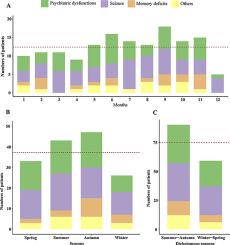Journal of Neuroimmunology ( IF 2.9 ) Pub Date : 2021-07-26 , DOI: 10.1016/j.jneuroim.2021.577673 Qi-Lun Lai 1 , Meng-Ting Cai 2 , Yang Zheng 2 , Tian-Yi Zhang 3 , Gao-Li Fang 4 , Chun-Hong Shen 2 , Song Qiao 1 , Yin-Xi Zhang 2

|
Objective
The aim of this study was to examine the seasonal distribution in clinical onset of autoimmune encephalitis (AE) in a multi-center cohort in China.
Methods
This retrospective study consecutively recruited patients with new-onset definite neuronal surface antibody-associated AE between January 2015 and December 2020 from 3 tertiary hospitals. Demographic and clinical characteristics of the participants were comprehensively collected. Statistical analyses were performed using R.
Results
Of the 184 patients of AE in our database, 149 (81.0%) were included in the final analysis. The median age of onset was 40.0 years, and 66 (44.3%) patients were female. AE predominantly started in autumn (47, 31.5%) and summer (43, 28.9%) months. Summer-autumn predominance of the clinical onsets was also present in the anti-N-methyl-d-aspartate receptor (NMDAR) encephalitis group (54, 60.0%) and anti-leucine-rich glioma inactivated 1 (LGI1) encephalitis group (20, 76.9%). No obvious seasonal variations were observed among gender, onset age, disease duration, prodromal symptoms, clinical type of initial symptoms, and disease severity by the time of admission.
Conclusion
This study suggested summer-autumn predominance of the clinical onsets in patients with AE, especially anti-NMDAR and anti-LGI1 encephalitis. Therefore, clinicians should have a high index of suspicion for AE in encephalopathy patients in summer and autumn period.











































 京公网安备 11010802027423号
京公网安备 11010802027423号